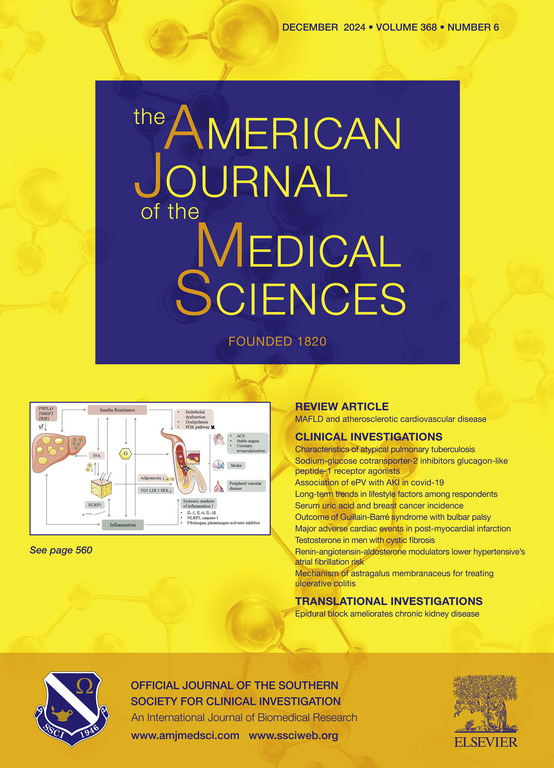Long-term trends in lifestyle factors among respondents with dyslipidemia in the United States
IF 1.8
4区 医学
Q2 MEDICINE, GENERAL & INTERNAL
引用次数: 0
Abstract
Objectives
To explore the long-term trends in unhealthy lifestyle factors and the risk sociodemographic subgroups among people with dyslipidemia.
Methods
Data extracted from the 1999 to 2018 National Health and Nutrition Examination Survey (NHANES). Lifestyle factors were smoking status, alcohol drinking, obesity, dietary quality, depression, physical activity, and sedentary behavior. A Joinpoint regression model was used to estimate trends in the log-transformed age-standardized prevalence. Multinomial logistic regression models adjusted for age, sex, and race/ethnicity were used to analyze subgroups by sociodemographic factors.
Results
Data for 33,680 respondents were extracted between 1999 and 2018. The prevalence of smoking and poor-quality diet decreased from 1999 to 2018 (P<0.001), while obesity significantly increased (P<0.001). The prevalence of depression marginally increased from 2005 to 2018 (P=0.074). We observed that non-Hispanic Black individuals, Hispanics, males, as well as those with lower family income-to-poverty ratios and education levels, unemployed individuals, or those lacking a spouse/live-in partner, were at elevated risk of unhealthy lifestyle factors when compared to the reference groups.
Conclusions
Among NHANES respondents from 1999 to 2018 with dyslipidemia, significant reductions in the prevalence of current smoking and poor diet were observed, while the prevalence of obesity was markedly increased. There were sociodemographic differences in the management of lifestyle factors. Further initiatives to encourage people with dyslipidemia are required to reduce potential adverse outcomes.
美国血脂异常受访者生活方式因素的长期趋势。
目的探讨不健康生活方式因素的长期趋势以及血脂异常人群中的风险社会人口亚群:从 1999 年至 2018 年美国国家健康与营养调查(NHANES)中提取数据。生活方式因素包括吸烟状况、饮酒、肥胖、饮食质量、抑郁、体力活动和久坐行为。接合点回归模型用于估计对数变换年龄标准化患病率的趋势。根据年龄、性别和种族/人种调整后的多项式逻辑回归模型用于分析社会人口因素的分组情况:提取了 1999 年至 2018 年间 33680 名受访者的数据。从 1999 年到 2018 年,吸烟和劣质饮食的流行率有所下降(P 结论:从 1999 年到 2018 年,吸烟和劣质饮食的流行率有所下降:在 1999-2018 年患有血脂异常的 NHANES 受访者中,观察到当前吸烟率和不良饮食率显著下降,而肥胖率明显上升。在管理生活方式因素方面存在社会人口差异。需要采取进一步措施鼓励血脂异常患者,以减少潜在的不良后果。
本文章由计算机程序翻译,如有差异,请以英文原文为准。
求助全文
约1分钟内获得全文
求助全文
来源期刊
CiteScore
4.40
自引率
0.00%
发文量
303
审稿时长
1.5 months
期刊介绍:
The American Journal of The Medical Sciences (AJMS), founded in 1820, is the 2nd oldest medical journal in the United States. The AJMS is the official journal of the Southern Society for Clinical Investigation (SSCI). The SSCI is dedicated to the advancement of medical research and the exchange of knowledge, information and ideas. Its members are committed to mentoring future generations of medical investigators and promoting careers in academic medicine. The AJMS publishes, on a monthly basis, peer-reviewed articles in the field of internal medicine and its subspecialties, which include:
Original clinical and basic science investigations
Review articles
Online Images in the Medical Sciences
Special Features Include:
Patient-Centered Focused Reviews
History of Medicine
The Science of Medical Education.

 求助内容:
求助内容: 应助结果提醒方式:
应助结果提醒方式:


